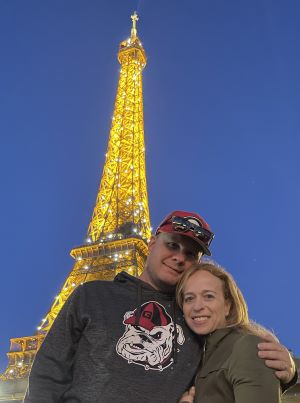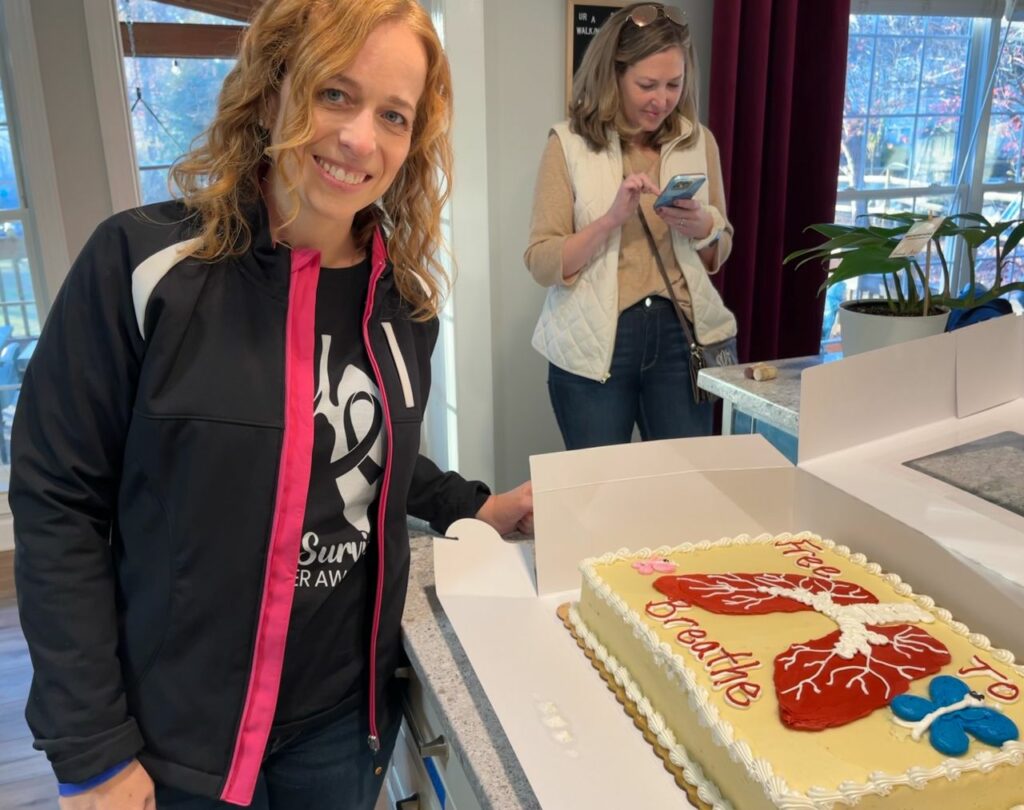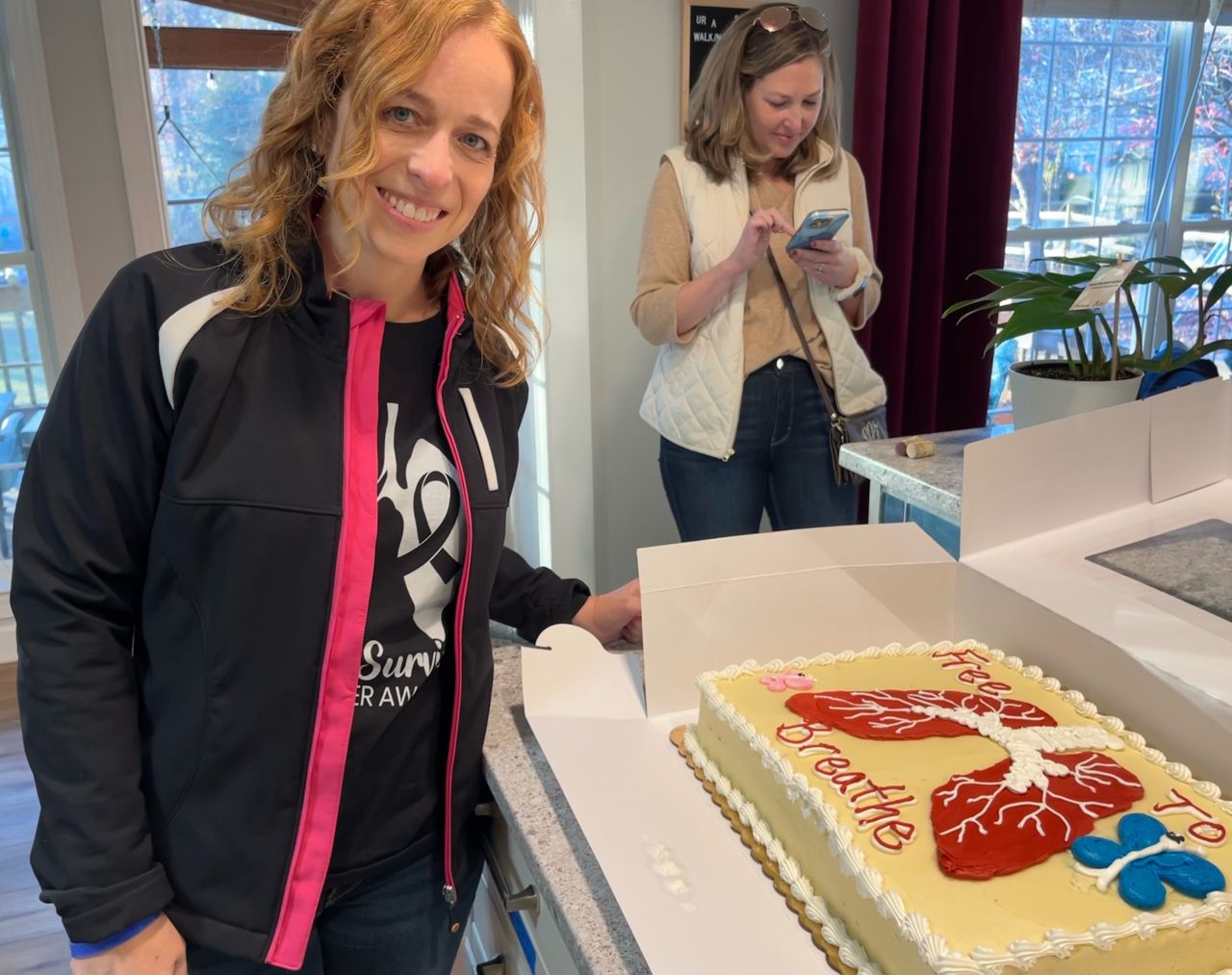February 2024

My lung cancer story began with a mammogram in February 2022. I was 42 years old, and it was my second one ever. All was well except for a calcified blood vessel, which they now flag as a potential sign of atherosclerosis. When I went in for my physical, my doctor noted this and, out of an abundance of caution, ordered a calcium score heart scan, and inexpensive CT scan. The scan resulted in me being put on a statin and revealed a 3 cm lung mass. I was so surprised by both of these things that I wasn’t even that worried the first month, certain they must have mixed up the scans! The next month, we got a chest CT with more detail, and it was still there. The radiologist report said “certainly, this may be adomatous.” I started to worry.
I was referred to a pulmonologist, who pulled up my scan and said that it did not look like Covid and most certainly was not supposed to be there. He asked me about risk factors and symptoms, which I had none of, and he had to note second hand smoke from my grandfather, which was barely the case, so that he could justify follow up. He ordered an emergency PET scan and a bronchoscopy. He told me that he didn’t think this mass would have shown up on a regular x-ray. The PET scan showed only the one mass, lighting up a little bit but not too much. It was a huge relief to know that nothing else was lighting up, but he confirmed that it should not be lighting up at all. Unfortunately, the mass was in a very difficult spot near blood vessels and close to my heart in my left lung, and he was not able to reach it for biopsy during the bronchoscopy. I was very disappointed to still not know for sure what was going on, but I understood that this was for my own safety. I was of course searching online for every single word in every report and getting into support groups for advice. This was actually a time that I needed support groups the most – before diagnosis but after the discovery of the mass.
Robotics for diagnosis
Someone in a support group suggested a robotic bronchoscopy, which makes it possible to reach tough-to-get spots. The other medical group in my area came up when I searched, so I made an appointment for a second opinion with a doctor in their group in hopes that I could get referred to the robotic team. Unfortunately, despite my going in person and signing forms weeks in advance, that doctor did not receive any imaging and only had the written reports. He seemed completely unconcerned and said “some people die with masses like these, not of them.” I said, “Are those people 42 years old?”
Weeks later, after I got another follow up CT to check for progression, he called me out of the blue, quite concerned. He had finally received the imaging, and he wanted to make sure he corrected the original impression he had given me. He told me he didn’t want to scare me but that it definitely looked suspicious. I told him I was already scared and had already requested a surgical consult because I was not comfortable with watching and waiting for a lung mass to prove it was cancer by growing. He seemed relieved. The original pulmonologist had also seemed relieved when I requested a surgical consult. I later thought that perhaps the doctors are instructed to follow a certain protocol – a flow chart – even if their intuition is telling them something different sometimes. Because patient preference can be a part of that protocol, my saying I wanted to talk to a surgeon was all it took to unlock that next step. There was no coordinator through this process trying to get a diagnosis. It was just me being persistent. I thought often about patients who are very busy with work or who do not wish to read as much about medical possibilities as I do.
When I visited the surgeon, he walked in the door and told me my whole story from the mammogram so that I did not have to repeat my story to him. I was immediately impressed. He referred me to a doctor about 1-2 hours away with a lot of experience in robotic bronchoscopy if I wanted to confirm diagnosis but also told me he was completely on board with removing the mass regardless because even benign masses can grow and cause issues. We decided to do it so we could be sure before major surgery. Being in a different town and a different medical group was a bit strange and made me more grateful for the care I had received to that point, even though it required my persistence and advocating for myself. However, the doctor himself was very experienced with the robotic bronch and got a successful biopsy. He was able to tell under the microscope in the room what it was and told my husband that it was indeed cancer. I did not know (or didn’t remember due to the drugs), and I remember a nurse asking me how they found the mass. They way she was talking to me told me right away that they had confirmed cancer. That was in August 2022. Strangely, this felt like a bit of relief because I finally knew for sure what it was and could confidently go ahead with surgery.
‘Cancer is not usually a great conversation starter’
I am the first person in my family to have cancer other than basal cell skin cancer. It was very surreal and unbelievable – it still is. I realized that I had no idea if I should tell other people or if I wanted to, and I also felt aware that it was such a heavy topic that it sometimes almost seemed unkind to tell someone about it. Cancer is not usually a great conversation starter. I gradually found that the more people I told, the more it helped me accept it as fact, and I felt supported and understood by those who were willing to talk about it with me and let me tell my story.
I had two friends who have had hard fights with breast cancer reach out right away with calls and gifts and cards. My sister – a medical writer with a background in pharmaceutical development – would get into the weeds with me and read the medical papers and research to decide what to do next, and I felt very supported by that. Many people sent cards and brought food while my husband was trying to handle the kids alone (even though he is normally our chef, that’s a lot harder when you are doing everything else!). My husband and I cried together a few times, and being able to just let out that fear mixed with a little bit of relief of dodging a bigger bullet. The No Surprises Act was passed not long before my surgery, and when I called my insurance and found out that I would not pay anything out of pocket for my surgery, I unexpectedly burst into tears.
When we told the kids, we assured them that it was caught early and that I would be okay, and they seemed to take it in stride. The surgeon told me very confidently that I was early stage and that surgery could cure me. While I appreciated his optimism, I also was very skeptical of this point of view. Lung cancer is quite an a-hole, and I still do not feel comfortable with the word “cure.” As much as I appreciated him, I felt more doubtful about follow up. He performed a lower left lobectomy in September 2022. It was a 3cm mass with about 9mm negative margins. Visceral pleural invasion was present, and so I am stage 1B.
I was only in the hospital for about 24 hours. They had me up and walking quickly. Even though it was hard and painful, I knew it was important. They removed the chest tube not even 24 hours after surgery, and I was sent home with only one night in the hospital. There were travel nurses who were just meeting each other, and while they did give me a pillow that people could sign, there was no one to sign it.
I developed a really annoying cough while recovering at home and couldn’t even speak for days because of it. We later learned that they had removed the chest tube too soon, and I had pleural effusion. I had to eventually have it drained in January at another provider. Recovery was otherwise not too bad – I did use a recliner for sleeping and walked as much as possible. There were nights, however, when I would search online for stories of survivors of lung cancer, and I would repeatedly come up empty. I found many stories of people like me who didn’t catch it in time or had recurrence. I had to tell myself that the people who survived didn’t need the support anymore or have a reason to speak out, so they were living their lives. I decided that for as long as I could, I would stay in support groups and tell this story so that people would be able to find a happy ending when they search at night.
I had a follow up about a month or two after surgery, and they said they would do CT scans every 6 months for follow up but that I otherwise did not qualify for any adjuvant therapy. I asked for an oncologist referral, and she shared the biomarker results with me. However, she misinterpreted the results and thought that the EGFR genetic mutation was only eligible for targeted therapy if it was L858R. I was exon 19 del. She also seemed to think that the targeted therapies listed on the report were in order of efficacy when they were actually just in alphabetical order. My sister helped me review the data and confirmed that I should get a second opinion and try to find an EGFR specialist. I am very grateful for the care I now receive at the Duke Cancer Center.
I was placed on Tagrisso (osimertinib) as targeted therapy to help hold back any potential microscopic cells still roaming around. I receive CT chest and abdomen scans with blood work every 3 months and MRI every 6 months. I believe the trial protocol for Tagrisso in people of my stage is 3 years, so I don’t know what will happen in 2025. I would feel more comfortable if I could stay on it 5 years.
When I was first diagnosed, I wish I had known how important and necessary second opinions are. You are not a hypochondriac if you are learning about your disease online – you are a warrior becoming an expert on the specific markers and aspects of what’s going on in your body, and that level of expertise is a strong asset when consulting with doctors. I wish I had known about the funding deficits despite being the most deadly cancer so that I could have advocated for lung cancer awareness and funding more when I was spending more time in medical facilities.
In November, for Lung Cancer Awareness Month, I decided to raise funds for research by having a Cancerversary party. People with lung cancer deserve more happy endings, and research will get us there.

